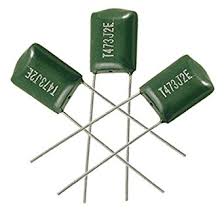Mylar capacitor
Mylar is the trade name for a type of polymer film. The technical name for Mylar is polyethylene terephthalate, often abbreviated as "PET" or polyester. In a typical Mylar capacitor, a thin film of Mylar is coated on both sides with a thin film of evaporated aluminum to form a plate capacitor. The metal-PET-metal structure is then rolled up to form a compact cylinder (called a capacitor roll). Capacitor rolls can then be used singly or combined in series and parallel to for capacitors with higher capacitance or higher working voltage. In a single rolled capacitor, zinc is then sprayed on the ends and wires soldered to the sprayed ends. The ends of the capacitor roll, and sometimes the entire roll itself, are often coated with a layer of epoxy to protect the capacitor from moisture. In larger high voltage or power capacitor, large numbers of identical capacitor rolls may be connected in series and/or parallel and the group then immersed in insulating oil and sealed inside a protective metal or plastic case. Mylar capacitors have low levels of moisture absorption. They are used on semicritical circuits with maximum voltage loads of 60,000 volts of direct current. They have replaced polystyrene film and metallized paper capacitors in that role. At low frequencies, Mylar capacitors can also be used with alternating current systems. This role is limited by the high levels of power loss that Mylar capacitors experience at temperatures above 257 degrees Fahrenheit. Mylar dielectric film is made from stretched polyethylene terephthalate.

